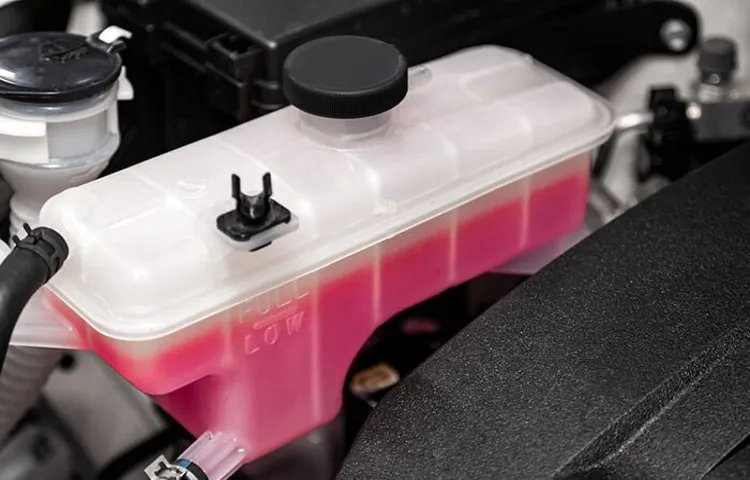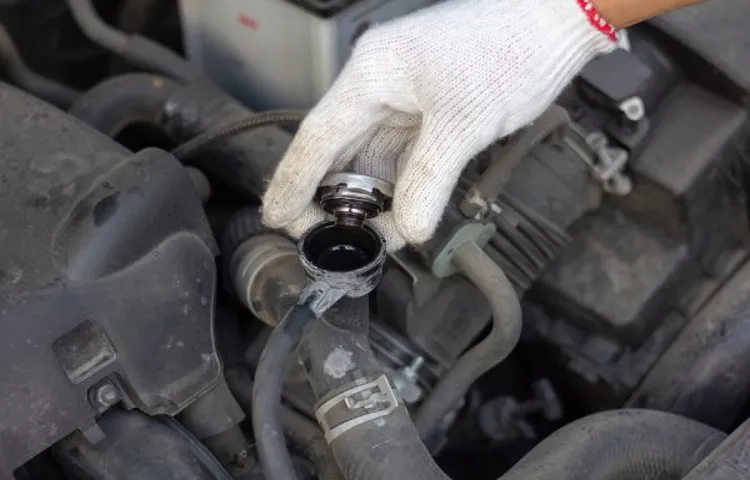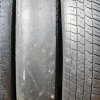Have you noticed a puddle of coolant under your car or a drop in your coolant levels? If so, you may have a coolant reservoir leak. A coolant reservoir, also known as an overflow tank or expansion tank, is a crucial component of your car’s cooling system. Its role is to collect and store excess coolant that expands as the engine heats up.
A coolant reservoir leak can cause several issues for your vehicle, including overheating and engine damage. It’s important to address this problem as soon as possible to prevent further complications. Luckily, fixing a coolant reservoir leak is a relatively straightforward process that you can do on your own with a few tools and a little patience.
In this blog post, we will guide you through the steps of fixing a coolant reservoir leak. We will discuss the causes of coolant reservoir leaks, how to diagnose the problem, and the necessary tools and materials you will need. Additionally, we will provide you with step-by-step instructions on how to fix the leak and ensure that your car’s cooling system is functioning properly.
Whether you are a seasoned car enthusiast or a novice DIYer, our detailed guide will give you the confidence to tackle this repair yourself. By following our instructions and taking the necessary precautions, you can save time and money by avoiding a costly trip to the mechanic. Remember, a coolant reservoir leak is not something you should ignore.
Act quickly to prevent further damage and keep your car running smoothly. Let’s get started on fixing that coolant reservoir leak and getting you back on the road in no time!
Table of Contents
Introduction
Are you experiencing a coolant reservoir leak and wondering how to fix it? Don’t worry, I’ve got you covered. A coolant reservoir leak can be a frustrating problem to deal with, as it can lead to overheating and potential engine damage. But with the right knowledge and tools, you can easily fix it yourself.
First, you’ll want to locate the source of the leak. Check for any cracks or holes in the reservoir itself, as well as any loose or damaged hoses. Once you’ve identified the problem, you can either repair or replace the faulty parts.
If it’s a small crack, you can use a sealant to patch it up. However, if the damage is extensive, it’s best to replace the reservoir or hose entirely. When fixing the leak, make sure to drain the coolant properly and refill it afterwards.
By taking these steps, you can effectively fix a coolant reservoir leak and keep your engine running smoothly.
Explanation of the coolant reservoir
The coolant reservoir is an essential component of a vehicle’s cooling system. It is designed to store and regulate the coolant, also known as antifreeze, which helps to keep the engine from overheating. But what exactly does the coolant reservoir do, and why is it important? When the engine is running, it generates a lot of heat.
This heat needs to be dissipated to prevent damage to the engine and its components. The coolant absorbs the heat and carries it away from the engine, where it is released into the surrounding air through the radiator. The coolant reservoir serves as a storage tank for the coolant, allowing for expansion and contraction as the engine heats up and cools down.
Think of the coolant reservoir as a buffer or a safety net for the cooling system. It ensures that the engine always has a sufficient supply of coolant, even when the system is under stress. For example, when you’re driving on a hot day or climbing a steep hill, the engine will generate more heat, causing the coolant to expand.
Without a coolant reservoir, this expansion could potentially cause damage by creating too much pressure in the cooling system. The coolant reservoir also plays a crucial role in maintaining the right mixture of coolant and water. The coolant needs to be diluted with water to improve its heat-transferring properties.
The reservoir allows for the addition of water or coolant as needed to maintain the correct balance. It also provides a convenient location for checking the coolant level and monitoring any leaks or other issues in the cooling system. In summary, the coolant reservoir is an important component of a vehicle’s cooling system.
It stores and regulates the coolant, allowing for expansion and contraction of the liquid as the engine heats up and cools down. It serves as a safety net for the cooling system, ensuring that there is always a sufficient supply of coolant to prevent overheating. It also allows for the maintenance of the correct coolant and water mixture and provides a convenient location for coolant level checks and diagnostics.

Importance of a functioning coolant reservoir
coolant reservoir, functioning coolant reservoir, importance of coolant reservoir, vehicle maintenance, overheating issues, coolant system, engine temperature, coolant level, coolant leak, radiator, vehicle performance, cooling system, automotive fluids, car maintenance, engine health, prevent engine damage, optimize engine performance, coolant expansion, replacement reservoir
Identifying a Coolant Reservoir Leak
Hey there! So you’ve noticed that your coolant reservoir is leaking, huh? Don’t worry, it’s a fairly common issue, and I’m here to help you fix it. A coolant reservoir leak can be a sneaky problem because it’s not always obvious where the leak is coming from. The first step is to locate the leak.
Start by checking the hoses connected to the reservoir for any cracks or signs of wear. If the hoses look good, the leak may be coming from the reservoir itself. In that case, you may need to replace the reservoir entirely.
Before you do that, though, make sure to check the radiator cap for any damage or looseness, as a faulty cap can also cause coolant leaks. If you’re unsure about any of this, it’s always a good idea to consult a professional mechanic who can diagnose and fix the issue for you. Remember, coolant leaks can lead to overheating and serious engine damage, so it’s important to address the problem as soon as possible.
Hope this helps, and good luck fixing that coolant reservoir leak!
Visible signs of a coolant reservoir leak
coolant reservoir leak, visible signs
Checking coolant levels and temperature
“coolant reservoir leak” Have you ever noticed a mysterious decline in your coolant levels? It can be quite frustrating trying to figure out where that precious fluid is disappearing to. One common culprit could be a coolant reservoir leak. This key component of your vehicle’s cooling system is responsible for housing and maintaining the coolant levels.
If there is a leak in the reservoir, it can lead to coolant loss and potential overheating of your engine. So, how can you identify a coolant reservoir leak? Well, first, you’ll want to visually inspect the reservoir for any signs of cracks or damage. Additionally, you can check for any puddles of coolant beneath your vehicle or a sweet, pungent smell coming from your engine bay.
If you suspect a coolant reservoir leak, it’s essential to get it repaired as soon as possible to prevent any further damage to your engine. So, make sure to keep an eye on your coolant levels and temperature and address any leaks promptly to keep your engine running cool and smooth.
Locating the Leak
So, you’re noticing a coolant reservoir leak in your car, huh? Don’t worry, it’s not the end of the world, but it is something you’ll want to address quickly to prevent any further damage. The first step is to locate the source of the leak. Start by inspecting the reservoir itself for any cracks or damage.
If you notice any, it’s likely that’s where the leak is coming from. However, if the reservoir appears to be in good condition, the next step is to check the hoses and connections. Sometimes a loose or damaged hose can be the culprit.
Give each hose a gentle tug to see if it moves or feels weak. Additionally, inspect the connections where the hoses attach to the reservoir and the engine. It’s possible that the leak is coming from a faulty connection.
Once you’ve pinpointed the source of the leak, you can take steps to fix it. If it’s a crack in the reservoir, you may need to replace it. However, if it’s a damaged hose or connection, you may be able to fix it by tightening or replacing the affected part.
Remember to always consult your car’s manual or seek professional advice if you’re unsure of how to proceed.
Inspecting the coolant reservoir for cracks or damage
coolant reservoir, cracks, damage, locating the leak
Checking the coolant hoses for leaks
coolant hoses, leaks, locating the leak When it comes to ensuring the proper functioning of your vehicle, checking the coolant hoses for leaks is crucial. Leaks in the coolant system can lead to overheating and potentially expensive repairs down the line, so it’s important to catch them early. The first step in this process is locating the leak.
One way to do this is by visually inspecting the coolant hoses for any signs of damage or wear. Look out for cracks, bulges, or any obvious signs of leakage. It’s also a good idea to check the hose clamps to ensure they are tight and secure.
Another method is to use a pressure tester to pressurize the system and see if any leaks become apparent. This allows you to identify the location of the leak more easily and make any necessary repairs. Remember, early detection is key when it comes to preventing damage to your vehicle’s coolant system.
So take the time to regularly check your coolant hoses for leaks and address any issues promptly.
Examining the radiator for leaks
radiator leaks. Are you noticing that your car’s engine is running hotter than usual? Is there a strange puddle of liquid underneath your vehicle? If so, you may be dealing with a radiator leak. The radiator is responsible for regulating the temperature of your engine, so it’s essential to keep it in good working order.
To locate the source of the leak, you’ll need to visually inspect the radiator. Start by parking your vehicle on a level surface and allowing the engine to cool completely. Once the engine is cool, open the hood and locate the radiator.
Look for any signs of moisture or wetness around the radiator and its hoses. Pay close attention to the seams, connections, and joints. Additionally, check the surrounding area for any signs of coolant residue.
If you notice any leaks or signs of damage, it’s important to address them promptly to prevent further engine damage. Remember, a small radiator leak can quickly escalate into a major problem if left untreated. It’s best to consult a professional mechanic for assistance with repairing or replacing a faulty radiator.
Taking care of any leaks promptly will ensure the longevity and efficiency of your vehicle’s cooling system. So don’t delay – inspect your radiator today and nip any potential problems in the bud. Your engine will thank you!
Fixing the Coolant Reservoir Leak
Are you noticing a mysterious leak in your car’s coolant reservoir? Don’t panic, because fixing a coolant reservoir leak is actually a relatively simple task that you can do yourself. First, you’ll need to identify the source of the leak. It could be a crack in the reservoir itself, a loose or damaged hose, or a faulty radiator cap.
Once you’ve pinpointed the problem, you can begin the repair process. If it’s the reservoir that’s cracked, you’ll need to replace it entirely. Luckily, coolant reservoirs are usually quite affordable and easy to find at your local auto parts store.
If it’s a hose that’s the culprit, you’ll need to remove and replace it. This can be a bit trickier, as you’ll need to drain the coolant and remove any other components that may be in the way. Finally, if it’s a faulty radiator cap, you’ll simply need to replace that.
With a new reservoir, hose, or cap in place, you should be good to go. Just be sure to refill the coolant and check for any other leaks before hitting the road again.
Replacing a cracked or damaged reservoir
coolant reservoir leak
Repairing a leaking coolant hose
coolant hose repair If you’ve noticed a pool of coolant under your car or the engine temperature rising, it’s possible that you have a leaking coolant hose. This is a common problem in older vehicles, as the hoses can degrade over time and develop cracks or leaks. Luckily, fixing a coolant reservoir leak is a relatively straightforward task that you can do on your own with just a few basic tools.
To start, you’ll want to locate the coolant reservoir, which is usually a plastic tank near the engine. Then, carefully inspect the hoses for any signs of damage, such as cracks, bulges, or leaks. If you notice any issues, it’s best to replace the hose completely rather than trying to patch it up.
Next, you’ll need to drain the coolant from the system to prevent any leaks or spills. This can usually be done by opening the radiator drain valve or removing the lower radiator hose. Make sure you have a catch pan ready to collect the coolant.
Once the coolant has been drained, you can remove the old hose by loosening the clamps with a screwdriver or pliers. Be careful not to damage the hose or surrounding components. With the old hose removed, you can install the new one by sliding it onto the fittings and tightening the clamps securely.
After the new hose is in place, it’s important to refill the coolant system with fresh coolant. Check your vehicle’s manual for the recommended coolant type and mix it with distilled water if necessary. Fill the coolant reservoir to the appropriate level and then start the engine to check for any leaks.
If you’ve followed these steps correctly, your coolant reservoir leak should be fixed and your car should be running smoothly again. However, if you’re not confident in your DIY skills or if the leak persists, it’s always a good idea to consult a professional mechanic for further assistance.
Fixing a leak in the radiator
fixing a leak in the radiator
Preventing Future Coolant Reservoir Leaks
If you’ve discovered a coolant reservoir leak in your car, it’s important to address the issue promptly to prevent any further damage to your vehicle. One way to fix a coolant reservoir leak is to identify the source of the leak first. This can be done by visually inspecting the reservoir for any cracks or damage.
Once the source of the leak is determined, you can then proceed to fix it. One common method is to use a sealant or adhesive designed specifically for coolant system repairs. These can be applied directly to the leak, effectively sealing it and preventing any further coolant loss.
Another option is to replace the entire reservoir if the damage is substantial or if the reservoir is aging. It’s important to remember that prevention is always better than a cure, so it’s a good idea to regularly check your coolant reservoir for any signs of wear or damage. This can help you catch any potential leaks early on and prevent them from becoming bigger problems.
By taking these preventative measures and addressing any coolant reservoir leaks promptly, you can help ensure the longevity and reliability of your vehicle’s cooling system.
Regularly inspecting the coolant reservoir and hoses
Regularly inspecting the coolant reservoir and hoses is essential for preventing future coolant reservoir leaks in your vehicle. When you take the time to inspect these components, you can catch any potential issues before they become major problems. Start by visually checking the coolant reservoir for any signs of cracks or leaks.
If you notice any damage, it’s important to replace the reservoir right away. Next, examine the hoses connected to the reservoir for any signs of wear or deterioration. Over time, hoses can become brittle and develop small cracks or leaks.
If you discover any issues with the hoses, it’s best to replace them to avoid any coolant leaks. By being proactive and regularly inspecting your coolant reservoir and hoses, you can help ensure that your vehicle’s cooling system remains in good working condition and avoid the inconvenience and potential damage of a coolant leak.
Using high-quality coolant and additives
Using high-quality coolant and additives is an effective way to prevent future coolant reservoir leaks in your vehicle. Coolant plays a crucial role in maintaining the optimal temperature of your engine, and using a high-quality coolant can help prevent leaks and ensure proper functioning. Additionally, adding the right additives to your coolant can also help prevent leaks by sealing small cracks or leaks in the reservoir.
These additives work by forming a protective layer on the surface of the reservoir, preventing any further leakage. By investing in high-quality coolant and additives, you can save yourself from the hassle and expenses of dealing with coolant reservoir leaks in the future.
Keeping the cooling system clean
In order to prevent future coolant reservoir leaks, it’s important to keep the cooling system clean. Over time, debris and dirt can accumulate in the coolant reservoir and cause blockages or damage to the system. Regularly inspecting and cleaning the reservoir can help to prevent these issues from occurring.
One way to clean the reservoir is to drain the old coolant and flush it out with clean water. This will help to remove any built-up debris and contaminants. Additionally, it’s important to check the hoses and connections for any signs of wear or leaks.
If any issues are detected, they should be addressed and repaired as soon as possible to prevent further damage. By taking these preventative measures, you can help to prolong the life of your cooling system and avoid costly repairs in the future. So, don’t forget to give your coolant reservoir some TLC and keep it clean for a smooth-running and leak-free cooling system.
Conclusion
In conclusion, fixing a coolant reservoir leak is like performing a magic trick – it requires the perfect blend of precision, knowledge, and just a hint of imagination. By following these steps, you’ll be able to patch up your coolant reservoir with such finesse that even Houdini himself would be impressed. Remember, a coolant reservoir leak shouldn’t be taken lightly.
Ignoring it could lead to disastrous consequences, like a car overheating or engine damage. So, grab your toolkit, put on your problem-solving hat, and get ready to banish that leak like a magician banishes a rabbit from a top hat. First, identify the source of the leak.
Is it a cracked tank or a loose hose? This is where your Sherlock Holmes deduction skills come into play. Once you’ve located the culprit, it’s time to roll up your sleeves and get to work. Start by draining the coolant from the system, being careful not to spill it everywhere like a clumsy magician pulling a tablecloth from under a fully set dinner table.
Once the coast is clear, remove the coolant reservoir from its cozy spot in the car, treating it as delicately as a magician handling a deck of cards. Next, inspect the reservoir for any cracks or damage. This is where your eagle eye vision comes in handy, as even the tiniest flaw can cause a big leak.
If you spot any imperfections, it’s time to whip out your handy-dandy repair kit and work your magic. Using a repair epoxy or sealant, carefully fill in the cracks, ensuring to apply it evenly and smoothly like a magician performing a flawless card trick. Allow the epoxy to cure, giving it the appropriate time to bond and strengthen the reservoir like an unbreakable chain.
Once the repair is complete, reattach any hoses or connectors, making sure they are secure and tight. Double-check your work, just as a magician double-checks their props before a big show, to ensure there are no lingering leaks waiting to steal the spotlight. Finally, refill the coolant reservoir with the appropriate mixture of coolant and water, precisely measuring it like a magician measuring the correct amount of ingredients for a spell.
Summary of steps to fix a coolant reservoir leak
coolant reservoir leak, fix a coolant reservoir leak, preventing coolant reservoir leaks
Importance of addressing the issue promptly
coolant reservoir leaks
FAQs
What are the signs of a coolant reservoir leak?
Some common signs of a coolant reservoir leak include low coolant levels, overheating engine, visible coolant puddles under the vehicle, and a sweet smell coming from the engine compartment.
Why is my coolant reservoir leaking?
Coolant reservoirs can develop leaks due to various reasons, such as a cracked reservoir, loose or damaged hoses, a faulty radiator cap, or a damaged coolant overflow tube.
Can I still drive my car with a coolant reservoir leak?
It is not recommended to drive with a coolant reservoir leak as it can lead to engine overheating and potential damage. It is best to address the issue promptly to avoid further problems.
How do I fix a coolant reservoir leak?
The fix for a coolant reservoir leak depends on the cause. It could involve replacing a cracked reservoir, tightening or replacing damaged hoses, replacing a faulty radiator cap, or fixing a damaged coolant overflow tube.
Can I use a temporary fix for a coolant reservoir leak?
While temporary fixes like using epoxy or sealants may temporarily stop the leak, it is always recommended to have the issue properly repaired by a professional to ensure a long-lasting solution.
How much does it cost to fix a coolant reservoir leak?
The cost of fixing a coolant reservoir leak can vary depending on the cause, the make and model of the vehicle, and the labor rates of the repair shop. It is advisable to get quotes from different mechanics to find the most affordable option.
How can I prevent a coolant reservoir leak?
Regular maintenance, such as checking coolant levels, inspecting hoses and connections, replacing worn-out parts, and using the recommended coolant, can help prevent coolant reservoir leaks. Additionally, avoiding excessive heat and pressure on the coolant system can also help extend its lifespan.



